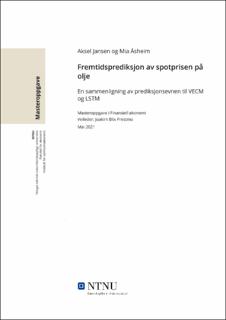| dc.description.abstract | I denne studien skal vi sammenligne prediksjonsevnen til to forskjellige modeller på oljeprisen. Modellene som benyttes er en vector error correction modell (VECM) basert på økonomisk teori og en Long-short term memory (LSTM) modell som er basert på maskinlæring.
Analysen tar utgangspunkt i månedlige observasjoner fra 2001(1) til 2018(12) (in-sample periode), mens prognosene er over tidsintervallet 2019(1) til 2021(3) (out-of-sample periode). Det vil bli benyttet to fremtidsprognoser i denne studien, en rullerende prognose for en måned frem i tid, t+1, og en for tre måneder frem i tid, t+3.
Sammenligningen baserer seg på resultatene fra fremtidsprediksjonene på én og tre måneder, der modellene vil bli evaluert ut fra evalueringskriteriene root mean square error (RMSE) og mean absolute percentage error (MAPE).
Fra analysen av fremtidsprediksjonene ga modellene tilnærmet like resultater. Gitt resultatene for t+1 prediksjonene gjør LSTM det bedre enn VECM, med en differanse på 0.55 USD/fat for RMSE og 0.57% for MAPE. For t+3 prediksjonene gjør VECM det bedre enn LSTM, differansen var her kun på 0.08 USD/fat for RMSE og 0.90% for MAPE.
Vi anser ikke resultatene for t+1 og t+3 prediksjonene å være tilfredsstillende, verken for VECM eller LSTM modellen. Grunnen til dette er at avvikene er av en betydelig størrelse, gitt RMSE og MAPE.
En mulig forklaringsvariabel til modellenes resultater kan være valg av tidsperiode. Med bakgrunn i dette velger vi å dele out-of-sample perioden i to nye evalueringsperioder, for å utelukke at det er tidsperioden som spiller en vesentlig rolle.
Disse periodene blir videre kalt «pre- og post Covid-19». Her finner vi at nye resultatene blir bedre for t+1 prognosene sammenlignet med hele perioden, mens resultatene for t+3 blir dårligere. Dette kan tyde på at det er modellspesifikasjonen som gir størst utslag på prediksjonene for begge modellene, og ikke tidsperioden i seg selv.
Konklusjonen om hvilken modell som presterer best er tvetydige, da ingen av modellene skiller seg vesentlig ut. Tatt i betraktning de seks forskjellige tidshorisontene prediksjonene er utført på, er det LSTM som gir de minste avvikene fire av disse seks periodene, gitt RMSE og MAPE. Med bakgrunn i dette kan det tyde på at LSTM modellen gir de beste fremtidsprediksjonene på oljeprisen. Vi ønsker likevel å gjøre oppmerksom på at differansene er små og det anbefales å gjøre ytterlige analyser før en endelig konklusjon tas. | |
| dc.description.abstract | In this study, the predictability of two different models will be compared while forecasting the oil price. The models used are a vector error correction model (VECM) based on economic theory and a Long-short term memory (LSTM) model based on machine learning.
The analysis consists of monthly observations from 2001(1) to 2018(12) (in-sample period), while the forecasts are over the time interval 2019(1) to 2021(3) (out-of-sample period).
The comparison is based on the results from the future predictions of one and three months, where the models will be evaluated based on the evaluation criteria’s root mean square error (RMSE) and mean absolute percentage error (MAPE).
Two future forecasts-periods will be used in this study, a rolling forecast of one month, t+1, and of three months, t+3. The comparison is based on the results from the future predictions of one and three months ahead, where the models will be evaluated based on the evaluation criteria RMSE and MAPE.
From the analysis of the future predictions, we found that the models performed very similarly. For the t+1 predictions, LSTM outperformed VECM, with a difference of 0.55 USD/barrel for RMSE and 0.57% for MAPE. While for the t+3 predictions, VECM outperformed LSTM. The difference here was only 0.08 USD/barrel for RMSE and 0.90% for MAPE.
We do not consider the results for the t+1 and t+3 predictions to be satisfactory, neither for the VECM nor the LSTM model. The reason for this is that the deviations are of a significant size, given RMSE and MAPE.
A possible explanatory variable for the models' results may be the choice of time-period. Based on this, we choose to divide the out-of-sample period into two new evaluation periods, to rule out that the time-period plays a significant role.
These periods are further called “pre and post Covid-19”. Here we find that new results are better for the t+1 forecasts compared to the whole out-of-sample period, while the results for t+3 are worse, given RMSE and MAPE. This may indicate that it is the model specification that has the greatest effect on both models’ predictions, and not the time-period itself.
The conclusion about which model performs best is ambiguous, as none of the models stands out significantly. Considering the six different time horizons the forecast is performed on, it is LSTM that gives the smallest deviations four of these six periods, given RMSE and MAPE. Based on this, it may indicate that the LSTM model provides the best future predictions on the oil prices. However, we would like to point out that the differences are small, and it is recommended to make further analyzes before a conclusion is made. | |
